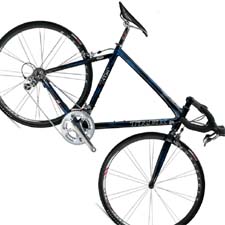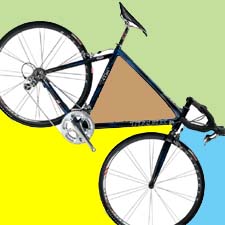| What I Ride |

SEACOAST BY BIKE
The Great Balkini tells all in this essay about his own personal wheels. Unless you are Lance Armstrong (and if you are – Hi, Lance!) this info is for you. Find out what a serious recreational rider takes to the pavement, WARNING: This nuts-and-bolts summary uses hardcore bike talk and lays bare the basics.
ABOUT the Great Balkini
I’m a road rider pure and simple. It’s what I do well, really enjoy and with great local roads out my front door it’s the best of all possible worlds. Although the motor is the magic, the equipment really helps. Owning a bike shop for a few years, 30 something years ago, spoiled me for life. Everything had to be the newest and the best because it was my job to report back and sell dreams.
When steel was king and Reynolds 531 and Columbus SL were the hi-tech materials of the day; that’s what I rode and couldn’t imagine anything better. But I eagerly tried out each advancing new technology -- aluminum, carbon and Ti frames were sketchy at first, but intriguingly light. It took years before they belonged in prime time.
In today’s world bikes are the poor man’s Ferrari. The frame carries the brand name, but a world of parts hang on the frame, and here’s where my I am forever updating already excellent equipment.
 When brake lever STI shifting first came about in 1993 it was a huge advancement and I had to have it. After 25 years of slavish devotion to Campagnolo, cycling’s most legendary brand, I switched to Shimano. Campy’s very first generation of brake lever shifting performed so poorly that the bike shop would not sell it to me. Campy fixed the problems in its second generation, but lost me forever.
When brake lever STI shifting first came about in 1993 it was a huge advancement and I had to have it. After 25 years of slavish devotion to Campagnolo, cycling’s most legendary brand, I switched to Shimano. Campy’s very first generation of brake lever shifting performed so poorly that the bike shop would not sell it to me. Campy fixed the problems in its second generation, but lost me forever.
For the record, I ride two identically dimensioned 58CM road frames. One is a carbon fiber Trek 5900SL, the other a carbon/aluminum Fuji Team Issue. Both are equipped with Shimano Dura-Ace 10-speed components from the pedals up. The only significant equipment difference is a Shimano Ultegra compact crank on the Fuji that I use as a travel bike in places where the climbs are much longer and steeper than around here. The Fuji is also my winter ride and a "beater" to abuse when the weather is sketchy.
The all-carbon Trek offers a noticeably smoother ride, handles more crisply than the Fuji and has greater rigidity. That is because the Trek fork is designed for its frame and far superior to the aftermarket, unbranded and undistinguished prototype that found its way to the Fuji. But I do not feel deprived on the Fuji. It rides well enough, and I prefer the lower gear ratios of the compact crank set up. When they make one in Dura-Ace, I will switch the Trek over for only because the Ultegra looks butt ugly by comparison.
The handlebars and stem are also different. While dimensionally identical, the Trek is all carbon (Bontrager/Easton) while the Fuji is alloy (Deda/Newton). Carbon fiber is more shock absorbing, but in recereational riding there is no discernible difference. I know that because my hands react the same way on every ride, no matter which bike I’m on. After an hour or my right hand gets sleepy and the left is always fine. I’ve also tried and removed both styles of Bontrager handlebar plugs designed to harmonically reduce road vibrations. Maybe they do, but you can’t prove it by me.
The saddles are also different, but both are minimalist. One is by Bontrager and the other a Specialized. The Specialized has split lobes designed to relieve pressure -- and maybe it does -- but I’m equally comfortable on either. Both are clamped to an Easton-EC-90 carbon seat post and in this application carbon’s shock absorbing properties are also lost on me as they feel no different than previous alloy seat posts.
The wheels on the Trek are Shimano DA 7801 tubeless compatible. Tubeless road tires are not available at this writing, but are scheduled to be introduced at an upcoming bike trade show. I have been promised a pre-intro set, but for now all tires are Vittoria CX and the tubes are Bontrager with a 48mm extended valve that makes it easier for a pump head to grip when inflating the tires.
The wheels on the Fuji are Shimano’s previous generation 7800 with a spare set of Shimano 7700’s and finally a conventional 32-spoke rear Mavic wheel with a Dura Ace hub. The beauty of using one brand is that all the wheels fit precisely without any adjustments of any kind.
It’s not possible to have too many wheels. They are the only part of the bike where durability is constantly challenged. Break one and the bike is dead in its tracks. Whenever I travel I take at least a spare rear wheel because that’s the one more likely to get damaged and almost impossible to replace on short notice. Front wheels are easy to beg or borrow.
All my rear wheels have a 12-27 Shimano Dura-Ace cluster that offers the widest gear ratio they make. The gaps make for slightly less precise shifting, and on this flat seacoast its overkill, but a blessing when the roads go up for a long time.
The Trek headset is a Chris King, while the Fuji has a slick looking proprietary unit. The Fuji cannot equal Chris King and when riding hard is a little loosey-goosey. The water bottles cages are Ti and made by a different King. These are as light as carbon and hold bottles tight over the bumpiest roads -- and that is very important.
Finally, I carry CO2 cartridges, an inflation device, two tire levers, a $20 bill and a cell phone in a carrier that occupies one of the water bottle cages. I generally ride less than three hours and stop if I want more water. On hot days I put the repair stuff in a back bike pocket and carry two bottles. I don’t like carrying a bag under the seat. It’s a throwback to race days when everything came off the bike that didn’t help me go faster.
Okay, you can put down your notebook and breathe now. I’m done.
Copyright (c) David Balkin 2006. All rights reserved.
